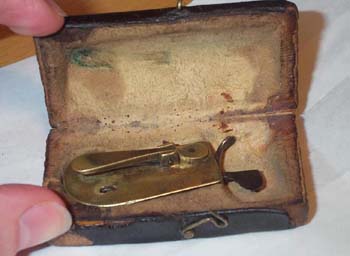Surgery |
||
Spring lancet (1) |
||
"Blood is a very special juice" - said Mephisto in 1808.
Charlatans used human and animal blood for their healing maneuvers: "If you cut a hole in the ear of a very black cat and let the drops of their blood run on a piece of bread and eat it, it will help against the fever".
Since antiquity, people are being blunted for a variety of reasons: high pressure, recognizable by the bright red head, internal poisoning by a bad mixture of the four cardinal juices. In the Middle Ages, Bader was responsible for the bloodletting, a craft guild responsible for haircuts and shaving, but also for minor operations and teeth removal. They used Aderlassmesser, so-called Flieten, with which they opened the blood vessels. This usually caused large wounds, because at the time, little was known about the course of the vessels.
The first cupping lancets were developed in the 15th century to make it easier to score the skin faster and thus painlessly. The Schnepper experienced their widest distribution in the 19th century. "In the 18th century, the use of Aderlassschnäpper was often used instead of the knife, a feather catapulting a small knife out of it.The pathological-anatomical Federal Museum in the Fool's Tower naturally also has some of these" modern "aids from the 18th and 19th centuries. The blood spurting from the vein was collected in a veined vial, usually decorated with pious motifs, measured the amount and judged according to various criteria such as color and coagulation ability to obtain indications for additional therapies. "Now as soon as the rotting with the blood is drained, followed by pure blood, and then you have to stop bleeding. "However, Hildegard von Bilgen's advice often does not seem to have been followed, or simply, there was no pure blood. Assuming a total volume of 24 liters of blood, one hardly knew restraint during the bloodletting "(PHARMACY WEEK).
The catch consisted of flexible, razor-sharp blades of 5 - 7.6 cm in length in folding sheaths made of ivory, tortoiseshell or mother of pearl. Shape and size seem to have changed little over time. In the early 19th century, the "automatic catch" was invented, a type of syringe whose head was jounced into the vein with a spring.
Exhibit Presented is a simple model without decoration, on the lid of the original box is in old German letters |




